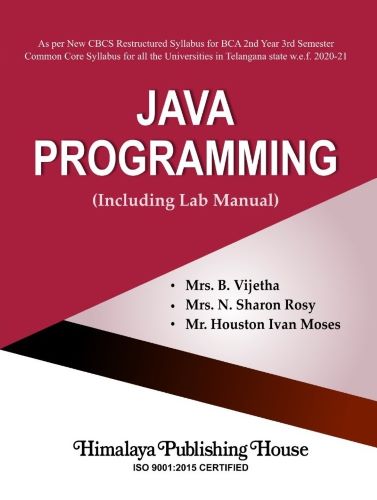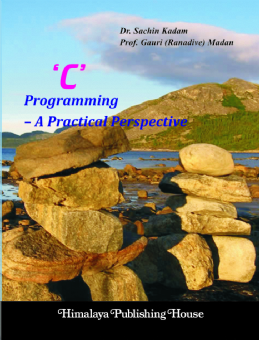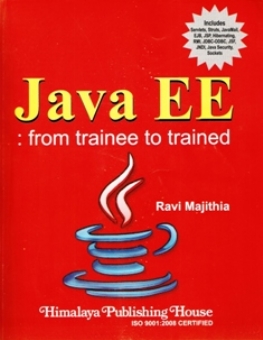The purpose of this book is to act as a textbook for undergraduates with a foundation in Computer Science. The purpose of this book is to introduce readers to Java Programming and demonstrate its usefulness for real-time programming.
This book is intended to help students pursuing their B.C.A., B.Sc. (Computer Science), and B.Tech degrees. This book is suitable for Students, New Programmers, and Self-learners. It includes the whole syllabus for the third semester of the BCA program as designed by Osmania University. The concepts of Java Programming are covered in great detail throughout the book. Graduate students can learn how to develop Java programs by using this book, which offers comprehensive examples and conceptual explanations.
This textbook is your comprehensive guide to learning Java, designed for both beginners and those with some programming experience. Java is a powerful, versatile, and widely-used programming language, perfect for everything from web and mobile apps to large-scale enterprise systems. Java’s ability to adapt to different environments and requirements has made it a preferred choice for developers around the world.
This book acts as a kind of instruction manual for programmers. The Basics of Java, Classes and Objects, Arrays, Strings, Inheritance, Exception Handling, Multithreading, GUI Design and Event Handling, File Handling, Generics and Framework are the numerous sections that make up the book.
The main features of the book include:
- Examples Programs with outputs for all the major topics are demonstrated for easy understanding for the students.
- Comprehensive exercises at the end of each unit.
- Important terms, marked in bold.
- Every chapter ends with a collection of short type, essay type, fill in the blanks and multiple choice questions.
- Executed lab programs along with the output.
Contents –
Unit I: Introduction to Java, Classes and Objects
1.1 Introduction to Java
1.1.1 Introduction
1.1.2 Java History
1.1.3 Features of Java
1.1.4 How java differ from C and C++?
1.1.5 Introduction to JDK and JRE
1.1.6 Java Primitive Types
1.1.7 Basic Operators
1.1.8 Conditional and Looping Statements
1.1.8.1. Conditional Statements
1.1.8.2. Conditional and Logical Statements
1.1.8.3. Looping Statements
1.1.9 Some Typical Differences between C and Java
1.2 Classes and Objects
1.2.1 Defining Classes and Adding Instance Fields and Methods
1.2.1.1 Defining a Class in Java
1.2.1.2 Declaration of Instance Fields/Variables
1.2.1.3 Declaration of Methods
1.2.2 Object Creation Examples
1.2.3 Constructors
1.2.4 Access Modifiers (Visibility Modes)
1.2.5 Method Overloading and Constructor Overloading
1.2.5.1 Method Overloading in Java
1.2.5.2 Constructor overloading
1.2.6 Use of Static and Final Keywords
1.2.6.1 static keyword in Java
1.2.6.2 final keyword in Java
1.2.7 Objects as Parameters
1.2.8 Difference between Local Variable and Instance Variables (field)
1.2.9 Introduction to Object Class
1.2.10 How to read user input (from keyboard)
1.2.10.1 Java Scanner Class
1.2.10.2 Java Command Line Arguments
1.3 Question Bank
Unit 2 Arrays, Strings, Inheritance, Interfaces, Packages, Inner Classes
2.1 Arrays, String in Java, Wrapper Classes
2.1.1 Arrays
2.1.1.1 Introduction
2.1.1.2 How to create and define arrays?
2.1.1.3 Introduction to java.util.Array Class
2.1.1.2 Strings
2.1.1.2.1 Difference between String and StringBuffer classes
2.1.1.2.2 StringTokenizer
2.1.3 Wrapper Classes and Conversion between Objects and Primitives
2.2 Inheritance, Interfaces in Java
2.2.1 Inheritance
2.2.1.1 Defining Super/subclasses
2.2.2 Abstract Classes
2.2.3 Method Overriding
2.2.4 Interfaces
2.2.5 Using Library Interfaces
2.2.6 Comparable and Comparator
2.2.6.1 Comparable Interface
2.2.6.2 Comparator Interface
2.2.7 Creating and Defining packages
2.3 Inner Classes in Java
2.3.1 Introduction
2.3.2 Types of Inner Classes
2.3.2.1 Creating Static/non-static Inner Classes
2.3.2.1.1 Static Nested Classes
2.3.2.1.2 Non-Static Inner Classes
2.3.2.1.2.1 Member Inner Class
2.3.2.1.2 Local and Anonymous Inner Classes
2.4 Question Bank
Unit-3 Exception Handling in Java, Multithreading in Java
3.1 Exception Handling in Java
3.1.1 What are Exceptions?
3.1.2 Writing your own Exception Classes
3.1.3 Try, Catch, Finally Throw, Throws Clauses
3.1.3.1 Try block
3.1.3.2 Catch block
3.1.3.3 Multiple catch statements
3.1.3.4 Finally block
3.1.3.5 Throw clause
3.1.3.6 Throws clause
3.1.4 Difference between Checked vs Unchecked Exceptions
3.1.5 Error vs Exception
3.2 Multithreading in Java
3.2.1 Introduction
3.2.2 Thread and its Life Cycle
3.2.3 How to create threads?
3.2.3.1 Thread class in Java
3.2.3.2 Runnable interface in Java
3.2.5 Use of Synchronized Keyword
3.2.6 How to avoid deadlock?
3.3 Question Bank
UNIT 4 GUI Design and Event Handling
4.1 Introduction to GUI, Event Handling and Java AWT
4.1.1 Component
4.1.1.1 Class declaration
4.1.1.2 Field
4.1.1.3 Class constructors
4.1.1.4 Methods of Component class
4.1.2 Container
4.1.2.1 Window
4.1.2.2 Panel
4.1.2.3 Frame
4.1.2.4 Dialog
4.1.3 Colour
4.1.4 GUI Controls
4.1.4.1 Types of GUI controls
4.1.5 Layout Managers
4.1.5.1 Some common layout managers in Java
4.1.6 Introduction to Swings
4.1.6.1 Differences between AWT and Swings
4.1.6.2 Swing key packages
4.1.6.3 Features of Swings
4.2 Event Handling
4.2.1 Events and Listeners
4.2.1.1 Event classes and Interfaces
4.2.2 Icon Interface
4.2.3 Writing GUI based applications
4.2.4 Applets
4.2.4.1 Life Cycle of Java Applet
4.2.5 Running applets
4.3 Question Bank
Unit 5 File Handling, Generics and Framework
5.1 File Handling
5.1.1 Stream Classes
5.1.1.1 Byte Stream
5.1.1.1.1 Input Stream Class
5.1.1.1.2 Output Stream Class
5.1.1.2 Character Stream
5.1.1.2.1 Reader Classes
5.1.1.2.2 Writer Classes
5.2.2 File and Directory Class
5.2.2.1 File Class
5.2.2.2 Directory Class
5.2 Generics and Framework
5.2.1 Generics
5.2.2 Collections Framework
5.2.2.1 Collection Interfaces
5.2.2.2 Collection Classes
5.2.2.2.1 ArrayList
5.2.2.2.2 LinkedList
5.2.2.2.3 Vector
5.3 Question Bank
Java Programming Lab Manual







